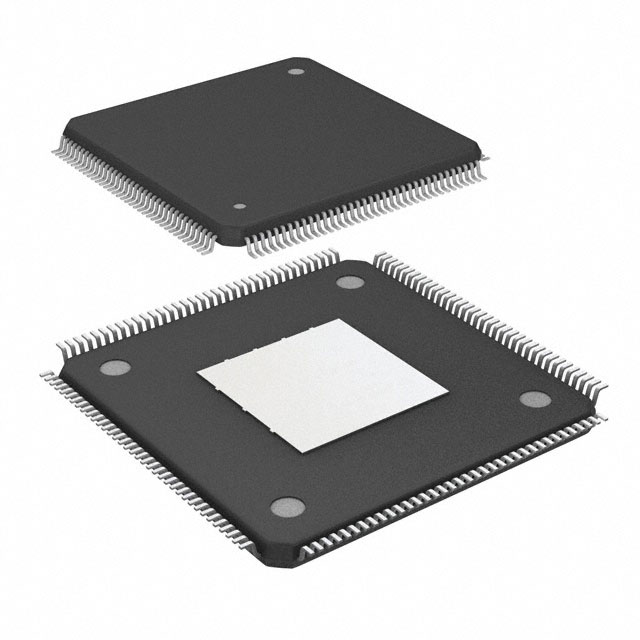Vedi le specifiche per i dettagli del prodotto.

EP4CE10E22I8L
Product Overview
- Category: Programmable Logic Device (PLD)
- Use: EP4CE10E22I8L is a PLD used for digital logic design and implementation.
- Characteristics: It offers high-performance, low-power consumption, and flexibility in designing complex digital systems.
- Package: The EP4CE10E22I8L comes in a small form factor package, making it suitable for space-constrained applications.
- Essence: This PLD allows users to program the device to perform specific functions based on their requirements.
- Packaging/Quantity: The EP4CE10E22I8L is typically sold in trays or reels, with quantities varying depending on the supplier.
Specifications
- Logic Elements: The EP4CE10E22I8L contains 10,320 logic elements, which can be configured as look-up tables, registers, or flip-flops.
- Embedded Memory: It includes 414 kilobits of embedded memory, which can be used for storing data or implementing small lookup tables.
- Clock Networks: The device features up to 378 global clock networks, allowing for precise timing control.
- I/O Pins: EP4CE10E22I8L has 179 I/O pins, providing connectivity to external devices.
- Operating Voltage: It operates at a voltage range of 1.15V to 1.25V.
- Speed Grade: The EP4CE10E22I8L is available in different speed grades, ranging from 6 to 8.
Pin Configuration
The EP4CE10E22I8L has a total of 324 pins, each serving a specific purpose in the device's functionality. The detailed pin configuration can be found in the product datasheet provided by the manufacturer.
Functional Features
- Flexibility: EP4CE10E22I8L offers a high degree of flexibility, allowing users to implement various digital logic functions.
- Reconfigurability: The PLD can be reprogrammed multiple times, enabling design changes without the need for hardware modifications.
- Low Power Consumption: EP4CE10E22I8L is designed to consume minimal power, making it suitable for battery-powered applications.
- High Performance: The device provides fast processing speeds, enabling efficient execution of complex digital designs.
Advantages and Disadvantages
Advantages: - Flexibility in designing complex digital systems - Reconfigurable nature allows for design changes without hardware modifications - Low power consumption - High-performance processing capabilities
Disadvantages: - Limited embedded memory capacity compared to other PLDs - Higher cost compared to simpler programmable logic devices
Working Principles
EP4CE10E22I8L operates based on the principles of field-programmable gate arrays (FPGAs). It consists of configurable logic blocks (CLBs), interconnects, and I/O elements. Users program the device using a hardware description language (HDL) or a graphical design tool. The programmed configuration is stored in non-volatile memory within the device and is used to control the behavior of the logic elements and interconnects.
Application Field Plans
EP4CE10E22I8L finds applications in various fields, including:
- Embedded Systems: It can be used in embedded systems for controlling and interfacing with external devices.
- Communications: EP4CE10E22I8L can be utilized in communication systems for signal processing and protocol implementation.
- Industrial Automation: It enables the implementation of control systems in industrial automation, such as robotics and process control.
- Medical Devices: The PLD can be integrated into medical devices for data acquisition, signal processing, and control functions.
- Automotive Electronics: EP4CE10E22I8L is suitable for automotive electronics applications, including engine control units and driver assistance systems.
Alternative Models
There are several alternative models available in the market that offer similar functionality to EP4CE10E22I8L. Some notable alternatives include:
- Xilinx Spartan-6 XC6SLX9
- Altera Cyclone IV EP4CE6
- Lattice iCE40HX1K
These alternative models provide varying levels of logic elements, embedded memory, I/O pins, and operating voltages. Users should consider their specific requirements and consult the respective datasheets for detailed specifications before selecting an alternative model.
In conclusion, EP4CE10E22I8L is a versatile programmable logic device with high-performance capabilities, low power consumption, and flexibility in digital logic design. It finds applications in various fields, offering advantages such as reconfigurability and fast processing speeds. However, it has limitations in terms of embedded memory
10 domande e risposte comuni relative all'applicazione di EP4CE10E22I8L nelle soluzioni tecniche
Sure! Here are 10 common questions and answers related to the application of EP4CE10E22I8L in technical solutions:
Q: What is EP4CE10E22I8L? A: EP4CE10E22I8L is a specific model of Field-Programmable Gate Array (FPGA) manufactured by Intel (formerly Altera).
Q: What are the key features of EP4CE10E22I8L? A: Some key features of EP4CE10E22I8L include 10,080 logic elements, 414 Kbits of embedded memory, and support for various I/O standards.
Q: What are the typical applications of EP4CE10E22I8L? A: EP4CE10E22I8L can be used in a wide range of applications such as industrial automation, telecommunications, automotive systems, and digital signal processing.
Q: How can EP4CE10E22I8L be programmed? A: EP4CE10E22I8L can be programmed using Hardware Description Languages (HDLs) like VHDL or Verilog, or through graphical programming tools like Quartus Prime.
Q: Can EP4CE10E22I8L be reprogrammed after initial programming? A: Yes, EP4CE10E22I8L is a reprogrammable FPGA, which means it can be reconfigured multiple times with different designs.
Q: What is the power supply requirement for EP4CE10E22I8L? A: EP4CE10E22I8L typically operates at a voltage range of 1.15V to 1.25V, but it also requires additional voltages for I/O banks and configuration.
Q: Does EP4CE10E22I8L support external memory interfaces? A: Yes, EP4CE10E22I8L supports various external memory interfaces such as DDR3, DDR2, and SDRAM.
Q: Can EP4CE10E22I8L interface with other devices or microcontrollers? A: Yes, EP4CE10E22I8L can interface with other devices using standard protocols like SPI, I2C, UART, or custom communication interfaces.
Q: What is the maximum operating frequency of EP4CE10E22I8L? A: The maximum operating frequency of EP4CE10E22I8L depends on the design and implementation, but it can typically reach several hundred megahertz.
Q: Are there any development boards available for EP4CE10E22I8L? A: Yes, Intel provides development boards like the DE0-Nano board that feature the EP4CE10E22I8L FPGA, allowing users to prototype and test their designs.
Please note that the answers provided here are general and may vary depending on specific requirements and use cases.

